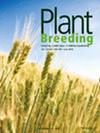Identifying quantitative trait locus and candidate genes for maize (Zea mays L.) plant architecture traits based on segregating populations constructed by high‐generation sister lines
IF 1.8
4区 农林科学
Q2 AGRONOMY
引用次数: 0
Abstract
Leaf length, width and angle are important traits in the architecture of maize plants. Delving into the genetic mechanisms of these traits is of utmost significance for promoting population yield. In this study, we employed the high‐generation sister lines PCU and PCM, which have significant differences in leaf morphological traits, as parental entities for the creation of F基于高代姊妹系构建的分离群体鉴定玉米(Zea mays L.)植物结构性状的数量性状位点和候选基因
叶片的长度、宽度和角度是玉米植株结构中的重要性状。研究这些性状的遗传机制对提高群体产量具有重要意义。本研究采用叶片形态性状差异显著的高代姊妹品系 PCU 和 PCM 作为亲本,创建 F2 和 F2:3 群体。通过 ICIM 对三个穗叶的性状进行定量性状位点(QTL)作图,获得了 55 个 QTL,其中 6 个稳定的 QTL 在不同的群体中被筛选出来。这些 QTL 的物理跨度从 0.34 到 44.8 Mbp 不等。通过基因注释和 qRT-PCR,Zm00001d007382、Zm00001d035965、Zm00001d042777 和 Zm00001d020641 被预测为调控玉米植株结构的潜在候选基因。该研究结果为分析玉米植株结构性状和克隆相关基因的遗传机制奠定了基础。
本文章由计算机程序翻译,如有差异,请以英文原文为准。
求助全文
约1分钟内获得全文
求助全文
来源期刊

Plant Breeding
农林科学-农艺学
CiteScore
4.40
自引率
5.00%
发文量
74
审稿时长
3.0 months
期刊介绍:
PLANT BREEDING publishes full-length original manuscripts and review articles on all aspects of plant improvement, breeding methodologies, and genetics to include qualitative and quantitative inheritance and genomics of major crop species. PLANT BREEDING provides readers with cutting-edge information on use of molecular techniques and genomics as they relate to improving gain from selection. Since its subject matter embraces all aspects of crop improvement, its content is sought after by both industry and academia. Fields of interest: Genetics of cultivated plants as well as research in practical plant breeding.
 求助内容:
求助内容: 应助结果提醒方式:
应助结果提醒方式:


